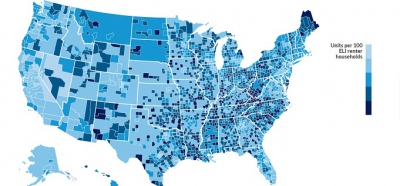Housing affordability challenges in high-cost cities often overshadow the enormous housing challenges in rural America. Though the situation is more extreme in metro areas, rural areas and small towns also face significant shortages of affordable and available rental housing, as most very low-income Vermonters well know.

As this housing affordability gap map from the Urban Institute (UI) illustrates, nearly every U.S. county lacks enough affordable housing to meet residents’ needs, a crisis that is particularly urgent for extremely low-income (ELI) households. Nationally, only 46 adequate and affordable rentals are available for every 100 ELI renter households—and without federal support, this problem would be significantly worse, according the UI's recent study.
Housing costs in rural areas are often lower than in metro areas, but so are incomes. In 2010, the rural poverty rate was 18 percent, compared with a 15 percent urban poverty rate.
In Vermont, HUD and USDA rental assistance enable the state to provide adequate, affordable housing for 51 to 66 percent of it's extremely low-income households, depending on the county. Without federal assistance, only 5 to 31% of these households would be housed adequately and affordably.
Use the map, to find statistics and assess how federal assistance impacts conditions where you live.
